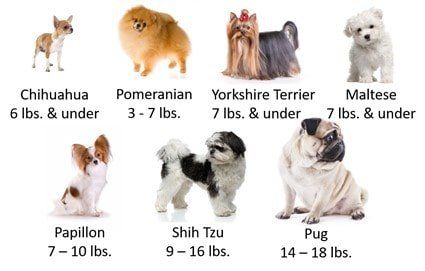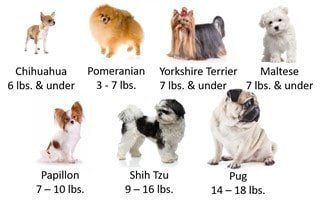Pomeranian Size
The Pomeranian is a toy sized breed which is the smallest size classification; though pet Poms (that do not compete in conformation shows) can often fall outside of the weight range seen in breed standards. In fact, many are notably larger.
This article will dive into size per the breed standards of all major kennel clubs, breed standard versus actual size, and more.
Pomeranian Breed Standard Sizes
A breed standard is a detailed description of a particular breed's appearance; it is meant to be used as a guideline for breeders in their attempts to produce dogs with a consistent look. This is what sets one breed apart from the other.
It also usually specifies such things as size (weight and/or height), color, and other physical attributes that
'ideal specimens' should have as well as aspects that are considered to be 'faults' and is used as a guideline for judges during conformation events.
So, while all purebred Pomeranians should fit the breed standard in regard to their overall appearance, it is certainly not expected that all pet Poms will fit into the rather limited weight range or otherwise exactly adhere to certain descriptors such as levelness of the topline, etc.
With this all in mind, let's take a look at the standards from the most popular kennel clubs.
American Kennel Club (AKC):
Weight: "3- 7 pounds with the ideal weight for show specimens being 4 to 6 pounds."
The metric conversion is 1.36 – 3.18 kg and 1.8 to 2.72 kg.
Height:
A height is not given; however, most Poms that are 3 - 7 pounds will be 8 - 11 inches (20.32 - 27.94 cm) tall, and this is measured from floor to withers (top of the shoulder blades).
Proportion: "The Pomeranian is a square breed with a short back. The ratio of body length to height at the withers being 1 to 1."
This means that the measurement from the floor the the top of the shoulder blades is the same as the measurement from the chest to the end buttocks.
The Kennel Club of the UK (KC):
Weight:
"Ideal weight: dogs: 1.8-2 kg (4 – 4 1/2 lbs.); bitches: 2-2.5 kg (4 1/2 - 5 1/2 lbs.)"
The Canadian Kennel Club (CKC):
Weight:
"The weight of a Pomeranian for exhibition is 3-7 lb. (1-3 kg). The ideal size for show specimens is from 4-5 lb. (1.8-2.3 kg)."
Federation Cynologique Internationale (FCI):
The FCI, which consists of 98 countries (at the time of this writing) groups the Pomeranian and other Spitz breeds as one, with variations in height (with no specific weight). The Pomeranian, as we know him, is the smallest of these and is also known as the 'Toy Spitz'.
Height:
"20 cm +/- 2 cm. Dogs under 18 cm undesirable", meaning that a range of 18 to 22 cm (7.09 to 8.67 inches) is preferred. Note that height is measured from the floor to the withers (top of the shoulder blades).
Weight
is simply stated as "should have a weight corresponding to its size". The weights that you’ll see with those meeting the FCI heights tend to be a tad smaller than 7 lbs.
Pomeranian Size Compared to Other Breeds
You may be wondering how small or large Pomeranians are in comparison to other breeds. However, it's important to note that just as it is with Poms, other breeds can also be larger than what is seen in the standard. The following is based just off of AKC breed standards and shows several of the most popular breeds in the toy group.
As you can see, the Pomeranian is one of the smallest toy breeds. In fact, only the Chihuahua has a smaller listed weight. The Pomeranian, at least in regard to standard guidelines, is on par with the Yorkshire Terrier and the Maltese. The Papillon, Shih Tzu, and Pug are notably larger in this regard. But, as you'll see coming up next, reported weights of pet Pomeranians brings some of them right in the range of these larger toy breeds dogs.
Actual Size of Pet Pomeranians
Breed standard guidelines are important documents. They specify the physical aspects of each purebred breed and this is what sets apart one from the other. This is very helpful for breeders in their quest to produce high-quality dogs and to fulfill a pledge to breed for the 'betterment of the breed'.
This said, some aspects, like size and weight, offer a very narrow range that most pet Poms cannot fit into, unlike their show -quality counterparts that compete in conformation events.
For this reason, a good number of Pomeranians are larger than the 3 to 7 pounds as seen in the AKC breed standard.
In 2018, PetPom conducted an online survey revolving around Pomeranian appearance, behavior, health, and personality. The full survey results can be found in PetPom's GIANT Book of Pomeranian Care. In regard to size, we asked only those with adult Poms 1 year and up (84%, a total of 3,104 Pomeranians) how much their Poms weighed. The results were as follows:
2.5 lbs. (1.13 kg) 0%
3 lbs. (1.36 kg) 1%
3.5 lbs. (1.58 kg) 1%
4 lbs. (1.81 kg) 2%
4.5 lbs. (2.04 kg) 2%
5 lbs. (2.26 kg) 5%
5.5 lbs. (2.49 kg) 5%
6 lbs. (2.72 kg) 5%
6.5 lbs. (2.94 kg) 6%
7 lbs. (3.17 kg) 5%
7.5 lb. (3.40 kg) 7%
8 lbs. (3.63 kg) 6%
8.5 lbs. (3.85 kg) 5%
9 lbs. (4.08 kg) 7%
10 lbs. (4.54 kg) 11%
More than this 29 %
I’m not sure! 3%
We're sure you'll agree these results are very interesting.
No adult Pomeranians were smaller than 3 lbs. And just a small percentage, 4%, were in the 3 to 4-pound range.
If we look at all adult Pomeranians that fell within the 3 to 7 pound range (which is the listed weight per AKC breed standards) just a minority of Poms, 32%, were this size.
Because 3% of the respondents were not sure of the answer, this shows that the majority of adult Pomeranians, 65%, were 7.5 pounds or larger.
Looking at just the 7.5 to 10-pound range, this was the size of 36% of the Pomeranians.
And, as you can see, 29% were bigger than 10 pounds.
A Note about Mini, Teacup, Toy, and Other Size-related Terms
There is only one Pomeranian breed, meaning that there are no official off-shoots or special varieties. Though, you may have heard the terms 'teacup Pomeranian', 'toy', 'miniature', 'micro' or other words or phrases that suggest that a Pom is smaller than average.
These are all just marketing terms meant to draw in potential puppy buyers and it's terribly misleading.
As we covered, the AKC breed standard lists a weight of just a mere 3 pounds minimum as does the CKC. The KC has a minimum weight of 4 pounds. So, it's nearly impossible for an adult Pomeranian to be any smaller than is already expected by these major organizations. And, as our survey showed, out 3104 adult Poms, exactly zero were smaller than 3 pounds.
Tips Regarding Pomeranians on the Small End of the Scale
This is Pooh, at 1 year old and just under 3 lbs. | Photo courtesy of Tammie
Because the Pomeranian is a toy breed, and even those on the larger side are small dogs (compared to medium or larger breeds), there are certain care tips that should be followed
regardless of a Pom's exact size.
However, with Pomeranians that have a very small stature and are in the 3 to 7 pound range, certain size-related health issues are seen more commonly. This includes hypoglycemia in which a dog's body has trouble regulating blood glucose levels with sometimes rapids drops that need to be treated asap; this can often be avoided with 3 to 5 small meals plus snacks spread throughout the day.
And structural issues like collapsed trachea may also be seen at a higher rate and therefore small Poms should always wear harnesses, not collars, when on leash.
Size-related injuries are much more common; children should be taught proper handling techniques and
and be supervised and if a small-than-average Pomeranian is a passenger in the car, a secure car seat
will help keep them safe.
Very tiny Poms may have trouble regulating body temperature and may be sensitive to chilly weather or even drafts in the house. A warm and cozy dog bed
will help. Clothing is often appreciated indoors and a 'must' outdoors during autumn and winter.
Larger than Average Pomeranians

Leo, 15.5 pounds at 1 year, 8 months
Photo courtesy of Eleni Elias

Seamus, 20 pounds at 10 months
Photo courtesy of Anna Marrs
Slightly larger:
As we covered earlier, our survey showed
that a great number of Pomeranians are bigger than the 7 pound maximum of the AKC breed standard. So, when we talk about 'larger than average Poms', many are actually very
average compared to the size of pet (not show) Pomeranians. As a reminder, out of 3104 adult Poms, 36% were 7.5 to 10 pounds and 29% were 10.5 pounds and up.
Why does this happen?
Though most reputable Pomeranian breeders
will aim to produce Poms that fit the AKC standard, it's risky for very tiny Poms to be bred. And females should always be larger than males. So, generally a 3 to 5 lb. female Pomeranian would not be part of a breeding program. The sturdier she is, the less risky (and easier) the pregnancy. Rather, females on the larger side are paired with studs and this introduces sturdier dogs into the gene pool.
Significantly larger: If a Pomeranian is 14 lbs. or more, this may be a matter of throwback genes or, in some cases, the dog may be a mixed breed of a Pomeranian and another Spitz dog (which can look exceedingly similar).
In regard to Pomeranian throwbacks, the Pomeranian's ancestors were much larger Spitz dogs. Once in a great while, a gene from many generations back can appear (be 'thrown'), which produces a Pomeranian that is double or triple the size of today's modern Pom.
Do you have your book?
If you have a Pom, you'll want to check out PetPom's GIANT Book of Pomeranian Care. This is the most comprehensive, helpful book of its kind, to guide you through every aspect of your Pom's life.
Related articles:
My Pomeranian is not gaining weight - Why this can happen, along with some tips and advice to encourage weight gain.
My Pomeranian is overweight
- While this is not common for the breed, some larger-boned Poms can indeed become overweight. Tips and advice for safe weight loss.
You may also like:
Pomeranian Harnesses
- Why a harness should be used, not a collar, any time a Pom is on a leash. Tips for comfort and a good fit.
Best Toys for a Pomeranian
- Our top picks for toys that can satisfy chewing urges, cure boredom, and even help if a Pom is home alone.





